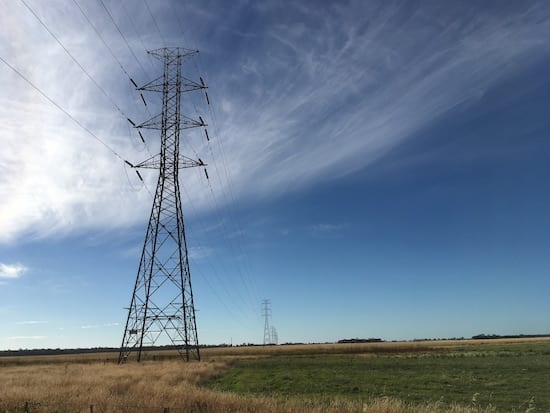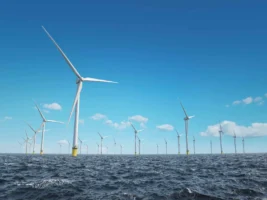A major new transmission line linking South Australia and New South Wales is being hailed by its proponents as the answer to the inevitable decline of black coal generation in NSW, and as a substitute to the gas generators that are the principal cause of high wholesale prices in renewables-dominated South Australia.
Transmission network companies ElectraNet and Transgrid on Wednesday delivered their final report into their proposal to build a $1.5 billion link between Robertstown in South Australia and Wagga Wagga in NSW. They have now dubbed the project “EnergyConnect”.
They say that the new 330kV line – with a capacity of around 800MW – will deliver sizeable benefits to the market and consumers, and unlock significant new wind and solar resources, considered crucial for NSW as it faces the closure of nearly all its coal fleet over the next 15 years.
The proposal now goes through a complex regulatory test known as RIT-T, but it has the support of the South Australia government and the Australian Energy Market Operator, which sees it as a crucial component of its Integrated System Plan, which analyses grid needs as South Australia approaches 100 per cent renewables, and predicts a dramatic transition in coal-dominated NSW.
And this is the significance of this proposal. Networks around Australia, whose role is to transport electrons around the country be they from brown, green or black generation sources, can see the future, and they have no doubt it is green, driven by wind and solar and various forms of storage.
“This is not an incremental change, this is a transformational change,” ElectraNet CEO Steve Masters told journalists at a briefing in Adelaide on Wednesday morning
Transgrid CEO Paul Italiano agreed, pointing to the 14,000MW of renewable energy applications to connect to the grid, and the prospect of the Snowy 2.0 pumped hydro scheme.
“That’s a phenomenal transformation of Australia’s electricity sector,” Italiano said. “A lot of it is taking place in NSW … as coal-fired power stations reach the end of their life.”
The big generators, who own the incumbent and threatened brown and black assets, can see the future too, but are less prone to admitting the speed of the transition lest the prospect scare their investors.
The final proposal from ElectraNet and Transgrid makes no bones about the speed of the transition ahead, and say their proposal will deliver twice the benefits to consumers than previously estimated.
“The retirement of coal generation is expected to be most rapid in New South Wales,” it says, noting that the state is facing the imminent closure of Liddell, and then Vales Point. By 2035, Bayswater and Eraring are also likely to close, leaving only Mt Piper out of the existing coal fleet.
They say that the new link will help deliver significant new wind and solar resources to NSW from South Australia. Already, several major projects at the South Australia end have unveiled their plans, and there are numerous solar projects totalling more than 600MW in the pipeline in the Riverina region of NSW that will also be unlocked.
ElectraNet also says that the new inter-connector – along with new energy storage in the form of batteries and pumped hydro – will help displace most of the existing and high-cost gas generation in South Australia.
“Our modelling shows that the South Australian gas generation capacity that retires with a new interconnector in place is more than offset by both new transfer capacity and energy storage,” the document says.
“The figure below shows that new transfer capacity effectively replaces the capacity lost from Torrens Island B retiring, while new energy storage replaces the equivalent capacity lost from Osborne and Pelican Point retiring.”
 This conforms with AEMO’s scenarios, which predict little gas generation in South Australia as new wind and solar is built and supported by a range of battery and other storage facilities, and new and upgraded links.
This conforms with AEMO’s scenarios, which predict little gas generation in South Australia as new wind and solar is built and supported by a range of battery and other storage facilities, and new and upgraded links.
The state earlier this week announced that more than 50 grid-scale projects had been proposed for its $50 million support scheme that will encourage a range of new energy storage projects, including batteries, pumped hydro, solar thermal, hydrogen and others.
And it hints that the new line will actually accelerate the closure of gas plants.
“A key component of the overall benefits for all new interconnector options across all scenarios is the ability to utilise lower cost generation on the east coast of the NEM to supply South Australia in the near term, reducing reliance on expensive gas-fired generation in South Australia.
“This will result in the wholesale price of electricity reducing in South Australia as soon as interconnection is established. It will also result in a reduction in gas consumption for power generation in South Australia.”
While this suggests a new market for black coal generators in NSW, it does not expect this to be long lived.
Of NSW, it says:
“Our assessment shows that a new interconnector between South Australia and New South Wales allows greater exports from existing and new high-quality renewable generation sources in South Australia and Western New South Wales …
“… that enables supply requirements in New South Wales to be met at a lower cost than if New South Wales was required to draw on other generation sources, including new gas generation, to fill the gap. Any earlier retirement of coal generation in New South Wales would accelerate delivery of these benefits.”
The document estimates annual bill savings of $66 to South Australian households and $33 to NSW households. Mostly this is delivered through reduced wholesale prices (it estimates $100 million a year).
This is double the estimates made in the interim report, which Masters credits to the additional amount of renewable energy it expects to unlock, particularly through the spur line to Victoria that will enable more wind and solar projects. These savings are only partly offset by a $9 a year cost to each consumer to fund the new link.
 Overall “market benefits” are estimated to be $900 million over 21 years. It predicts a nine-year payback on investment; $6 billion in wider economic benefits; 200 regional jobs in South Australia and over 800 regional jobs in NSW during construction; and around 250 and 700 ongoing jobs in South Australia and NSW respectively.
Overall “market benefits” are estimated to be $900 million over 21 years. It predicts a nine-year payback on investment; $6 billion in wider economic benefits; 200 regional jobs in South Australia and over 800 regional jobs in NSW during construction; and around 250 and 700 ongoing jobs in South Australia and NSW respectively.
It also includes a “spur” line from Buronga to Red Cliffs in Victoria, which will also help unlock more capacity from north-west Victoria, where wind and solar proposals face considerable constraints because of the lack of network capacity.
Mostly, though, this is about the enabling and unlocking of cheaper renewables.
South Australia Premier Steve Marshall voiced his support for the proposal. “The interconnector will also help drive the future development of our renewable energy sector, opening up NSW’s energy market for SA’s wind and solar farms,” he said.
“Frankly, this interconnector should have been built a decade ago.”
That’s a moot point. It could be argued it should have been built two decades ago, but the previous Liberal government agreed not to build one then because it wanted to increase the value of the generation assets it privatised. There’s a strong case to say that South Australians are now paying the price for that.
The Labor government instead focused on building wind and solar to reduce the dependence on coal and gas. It did not want to build the interconnector until there was sufficient local capacity installed to ensure that the local market was not beholden to interstate plants.
ElectraNet hopes to get approval for the new transmission line by the middle of this year, stunningly quick in the traditionally glacial pace of regulatory decisions in Australia. Should that happen, it hopes to complete the 900km line by 2022, in time – one suspects – for the closure of Liddell.










